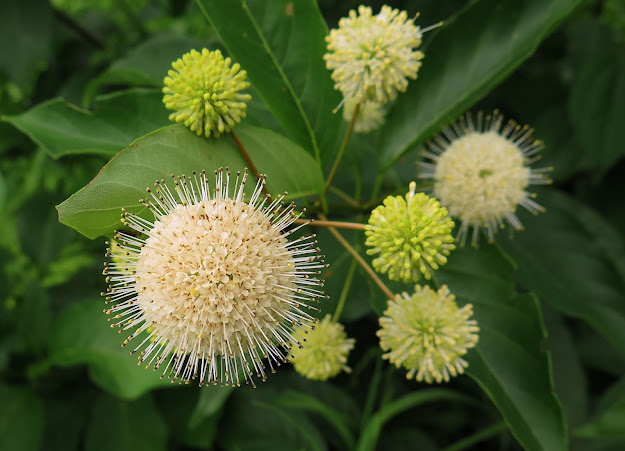The days have continued too hot for hiking. Unfortunately, that has usually led to afternoon naps instead. Before I turn into a lump, I told myself, I've got to get outdoors. Let's go for a paddle on the nice cool Hudson, I said. But when I got to the shore, I found that much of the river had disappeared, due to work being done on a downstream dam.
I would have to cross yards of ankle-deep mud to reach what was left of the water. And then I'd be paddling out under the sun, far from the forest's overhanging shade and also far from any of the riverside flowers I'd hoped to admire in bloom. Not what I wanted to do today. OK, so what's Plan B?
I decided to head to Mud Pond instead. Not for a paddle -- this water's too shallow and clogged with aquatic plants -- but just to visit the shore. There's always
something of interest along this shore. (Remember all those
sex-crazed toads and the
thousands of tiny toadlets that resulted from all that ardor?)
Today, the points of interest were floral, not animal, for the shore was crowded with masses of flowering plants. How pretty these rosy Steeplebush spires (
Spiraea tomentosa) appeared in the company of their neighboring (and related) Meadowsweet (
Spiraea alba).
The Buttonbushes (
Cephalanthus occidentalis) were loaded with blooms, perfect orbs of exploding florets shooting out spiky stamens. Before I moved in close to shoot this photo, this flower head was alive with several nectar-seeking insects. Sadly, they fled before I could snap their photo!
I had arrived too late in the day to catch the now-snoozing Fragrant Water Lilies in open bloom, but other flowers had protruded their flowering stalks among the lily pads. Water Smartweed (
Persicaria amphibia) held spikes of tiny pink florets well above their own floating leaves, while leafless stalks of Common Bladderwort (
Utricularia vulgaris) held chubby yellow blooms above the water.
Here's a closer look at the flower of Common Bladderwort. Submerged below these flowering stems were masses of the bladderwort's underwater structures. These structures hold tiny sacs that suck in even tinier aquatic creatures that the plant digests, thus providing nutrients that this leafless plant could not obtain through photosynthesis.
Sharing the shallow water and muddy shore with many other wetland plants were these spiky leaves and Sputnik-shaped blooms of a species of Bur Reed (
Sparganium sp.).
Northern Dewberry vines (
Rubus flagellaris) lined the sandy trail leading down to the pond, and many of these vines held jewel-colored fruits in various stages of ripeness.
This open, sandy-soiled area is just the habitat that suits Round-headed Bushclover (
Lespedeza capitata), a native Clover-family plant, and I found several just coming into bloom. Granted, this plant can appear rather homely from a distance, but a close look reveals some rather pretty, pink-striped white florets nearly hidden among the plant's bushy green bracts.
There's a huge thicket of Shining Sumac (Rhus copallinum) that stands between the pond and the road, and I was delighted to find the shrubs looking green and healthy, their winged leaves as glossy as this shrub's common name suggests. (Another common name is Winged Sumac, after the wings along the leaves's stems.) For years, this thicket has been affected by some plant disease that caused the shrubs' leaves to shrivel before the shrubs produced flowers or fruit. But this year, nearly every shrub held conical clusters of tiny green florets. I sure hope this good health persists until the flowers can yield their handsome clusters of red berries in the fall.
Passing through a narrow strip of pine woods on the way to my car, I came upon this dark shaggy mushroom that goes by the oddly appropriate name of Old Man of the Woods. Its scientific name is
Strobilomyces floccopus, which means something like "woolly mushroom that resembles a pinecone," perhaps a more accurate descriptor! Despite its rather off-putting appearance, this mushroom is said to be edible.
I found some other, more photogenic mushrooms nearby, some very small specimens of what I believe are Cinnabar Chanterelles (
Cantharellus cinnabarinus). This one is also said to be edible, but you couldn't feed many people with this tiny cluster of them. I was content to leave both mushrooms where I found them.












Those Mushrooms are also delicious in sauces. In Europe people gather them in the woods. Very nutritious.
ReplyDeleteSince many poisonous mushrooms closely resemble some edible varieties, I won't eat any but the easily recognizable puffballs and morels. The high fatality rate of some toxic varieties just isn't worth the risk. But, many species are very photogenic, including some of the most toxic.
ReplyDeleteAt least you got out! I've only seen Buttonbush once, many years ago. It barely makes it into southern Ontario.
ReplyDeleteWoody, my go-to rule for determining the edibility of a mushroom is: if there is a pizza under it.
ReplyDelete